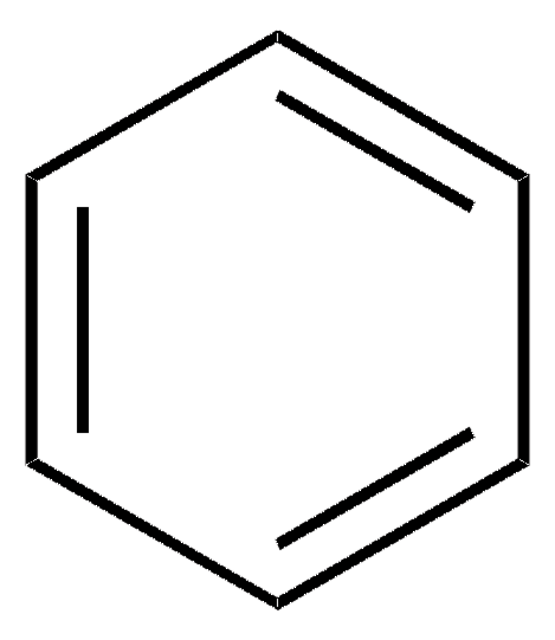32212
Benzene
puriss. p.a., reag. Ph. Eur., ≥99.7%
About This Item
Prodotti consigliati
agenzia
ISO
USP/NF
reag. Ph. Eur.
Livello qualitativo
Densità del vapore
2.77 (vs air)
Tensione di vapore
166 mmHg ( 37.7 °C)
74.6 mmHg ( 20 °C)
Grado
puriss. p.a.
Saggio
≥99.7%
Forma fisica
liquid
Temp. autoaccensione
1043 °F
Limite di esplosione
8 %
Impurezze
≤0.0002% free alkali (as NH3)
≤0.0004% free acid (as HCl)
≤0.001% non-volatile matter
≤0.03% water (Karl Fischer)
≤1 ppm thiophene
Colore
APHA: ≤10
Indice di rifrazione
n20/D 1.5000-1.5020
n20/D 1.501 (lit.)
P. eboll.
80 °C (lit.)
Punto di fusione
5.5 °C (lit.)
Temp. transizione
solidification point ≥5.2 °C
Densità
0.874 g/mL at 25 °C (lit.)
Cationi in tracce
Al: ≤0.5 mg/kg
B: ≤0.02 mg/kg
Ba: ≤0.1 mg/kg
Ca: ≤0.5 mg/kg
Cd: ≤0.05 mg/kg
Co: ≤0.02 mg/kg
Cr: ≤0.02 mg/kg
Cu: ≤0.01 mg/kg
Fe: ≤0.1 mg/kg
Mg: ≤0.1 mg/kg
Mn: ≤0.02 mg/kg
Ni: ≤0.02 mg/kg
Pb: ≤0.01 mg/kg
Sn: ≤0.1 mg/kg
Zn: ≤0.01 mg/kg
Stringa SMILE
c1ccccc1
InChI
1S/C6H6/c1-2-4-6-5-3-1/h1-6H
UHOVQNZJYSORNB-UHFFFAOYSA-N
Cerchi prodotti simili? Visita Guida al confronto tra prodotti
Categorie correlate
Descrizione generale
Applicazioni
Altre note
Avvertenze
Danger
Indicazioni di pericolo
Consigli di prudenza
Classi di pericolo
Aquatic Chronic 3 - Asp. Tox. 1 - Carc. 1A - Eye Irrit. 2 - Flam. Liq. 2 - Muta. 1B - Skin Irrit. 2 - STOT RE 1
Organi bersaglio
Blood
Codice della classe di stoccaggio
3 - Flammable liquids
Classe di pericolosità dell'acqua (WGK)
WGK 3
Punto d’infiammabilità (°F)
12.2 °F
Punto d’infiammabilità (°C)
-11 °C
Certificati d'analisi (COA)
Cerca il Certificati d'analisi (COA) digitando il numero di lotto/batch corrispondente. I numeri di lotto o di batch sono stampati sull'etichetta dei prodotti dopo la parola ‘Lotto’ o ‘Batch’.
Possiedi già questo prodotto?
I documenti relativi ai prodotti acquistati recentemente sono disponibili nell’Archivio dei documenti.
I clienti hanno visto anche
Il team dei nostri ricercatori vanta grande esperienza in tutte le aree della ricerca quali Life Science, scienza dei materiali, sintesi chimica, cromatografia, discipline analitiche, ecc..
Contatta l'Assistenza Tecnica.






